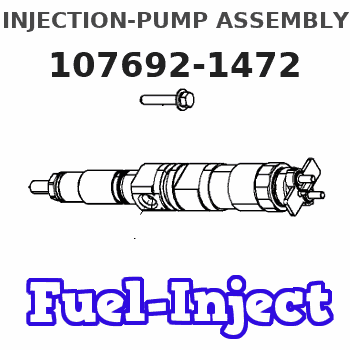Information injection-pump assembly
BOSCH
9 400 612 389
9400612389
ZEXEL
107692-1472
1076921472
ISUZU
8976005761
8976005761

Rating:
Service parts 107692-1472 INJECTION-PUMP ASSEMBLY:
1.
_
5.
AUTOM. ADVANCE MECHANIS
7.
COUPLING PLATE
11.
Nozzle and Holder
8-94390-795-4
12.
Open Pre:MPa(Kqf/cm2)
18.1{185}/22.1{225}
14.
NOZZLE
Include in #1:
107692-1472
as INJECTION-PUMP ASSEMBLY
Cross reference number
Zexel num
Bosch num
Firm num
Name
9 400 612 389
8976005761 ISUZU
INJECTION-PUMP ASSEMBLY
6HH1 * K 14CG TICS MD-TI6 TICS
6HH1 * K 14CG TICS MD-TI6 TICS
Information:
Engine and Attachment Lifting
When it is necessary to remove a component on an angle, remember that the capacity of an eyebolt is less as the angle between the supporting members and the object becomes less than 90 degrees. Eyebolts and brackets should never be bent and should only be loaded in tension.
Use a hoist to remove heavy components. Lift the engine by using an adjustable lifting beam. All supporting members (chains and cables) should be parallel to each other, and as near perpendicular as possible to the top of the object being lifted.To remove the engine ONLY, use the lifting eyes equipped with the engine. Lifting eyes are designed for the arrangement as sold and the end user is responsible for providing lifting devices. Alterations to lifting eyes and/or arrangement weight make the lifting eyes and devices obsolete. If you make alterations to the engine package as sold, you are responsible for providing adequate lifting devices.Engine Storage
These instructions and recommendations will safeguard the possibility of engine damage if the engines are in storage for one year or less.If the engine will not be or has not been started for several weeks, the lubricating oil will drain from the cylinder walls and piston rings.If an engine remains out of service and its use is not immediately planned, special precautions should be taken. Rust can form on the cylinder liner surface, which will increase engine wear and may result in shorter engine life. To prevent this problem from becoming excessive, be sure all lubrication recommendations mentioned in the Maintenance Schedule are completed.After one year, a complete protection procedure must be followed if the engine is kept in storage longer.If it will be impossible to start the engine periodically, consult your Caterpillar dealer for instructions to prepare your engine for longer storage periods.If an engine remains out of service and its use is not immediately planned, special precautions should be taken. Refer to Storage Procedures For Caterpillar Products, SEHS9031 for more detailed information on engine storage. To prevent excessive engine wear:Be sure all lubrication recommendations mentioned in the Maintenance Schedule intervals chart are completed.If freezing temperatures are expected, check the cooling system for adequate protection against freezing. A 50/50 solution of Caterpillar permanent-type antifreeze and approved water will give protection below -29°C (-20°F). The engine can be stored between temperatures -50°C (-58°F) and 85°C (185°F).
When it is necessary to remove a component on an angle, remember that the capacity of an eyebolt is less as the angle between the supporting members and the object becomes less than 90 degrees. Eyebolts and brackets should never be bent and should only be loaded in tension.
Use a hoist to remove heavy components. Lift the engine by using an adjustable lifting beam. All supporting members (chains and cables) should be parallel to each other, and as near perpendicular as possible to the top of the object being lifted.To remove the engine ONLY, use the lifting eyes equipped with the engine. Lifting eyes are designed for the arrangement as sold and the end user is responsible for providing lifting devices. Alterations to lifting eyes and/or arrangement weight make the lifting eyes and devices obsolete. If you make alterations to the engine package as sold, you are responsible for providing adequate lifting devices.Engine Storage
These instructions and recommendations will safeguard the possibility of engine damage if the engines are in storage for one year or less.If the engine will not be or has not been started for several weeks, the lubricating oil will drain from the cylinder walls and piston rings.If an engine remains out of service and its use is not immediately planned, special precautions should be taken. Rust can form on the cylinder liner surface, which will increase engine wear and may result in shorter engine life. To prevent this problem from becoming excessive, be sure all lubrication recommendations mentioned in the Maintenance Schedule are completed.After one year, a complete protection procedure must be followed if the engine is kept in storage longer.If it will be impossible to start the engine periodically, consult your Caterpillar dealer for instructions to prepare your engine for longer storage periods.If an engine remains out of service and its use is not immediately planned, special precautions should be taken. Refer to Storage Procedures For Caterpillar Products, SEHS9031 for more detailed information on engine storage. To prevent excessive engine wear:Be sure all lubrication recommendations mentioned in the Maintenance Schedule intervals chart are completed.If freezing temperatures are expected, check the cooling system for adequate protection against freezing. A 50/50 solution of Caterpillar permanent-type antifreeze and approved water will give protection below -29°C (-20°F). The engine can be stored between temperatures -50°C (-58°F) and 85°C (185°F).